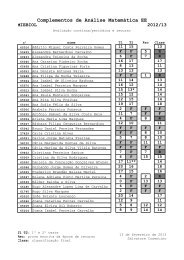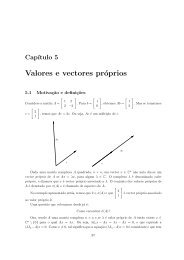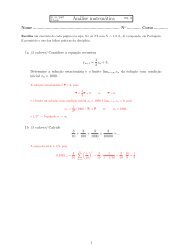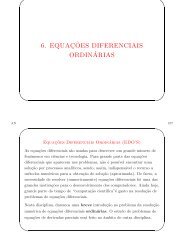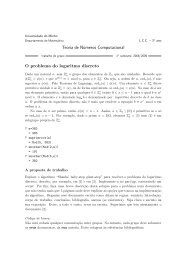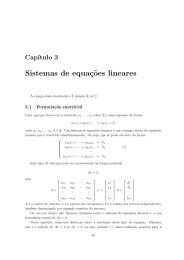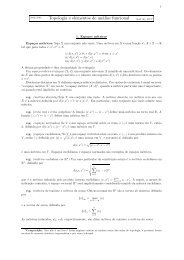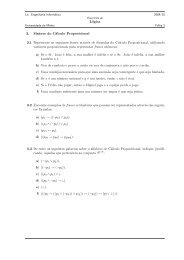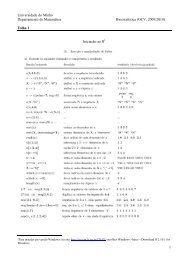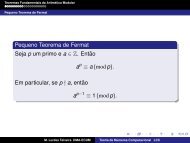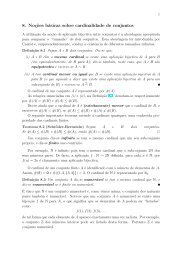My title - Departamento de Matemática da Universidade do Minho
My title - Departamento de Matemática da Universidade do Minho
My title - Departamento de Matemática da Universidade do Minho
Create successful ePaper yourself
Turn your PDF publications into a flip-book with our unique Google optimized e-Paper software.
10 STATISTICAL DESCRIPTION OF ORBITS 66<br />
Observe that an en<strong>do</strong>morphism f of a measurable space (X, E) acts naturally on the space of<br />
measures on E by ”push forward”: if µ is a measure, then f ∗ µ, <strong>de</strong>fined by (f ∗ µ) (A) = µ ( f −1 (A) )<br />
for any A ∈ E, is also a measure.<br />
Let f be an en<strong>do</strong>morphism of the measurable space (X, E). A probability measure µ on E is<br />
invariant (w.r.t. the transformation f) if f ∗ µ = µ, namely if<br />
µ ( f −1 (A) ) = µ (A)<br />
for any A ∈ E. If this happens, we also say that f is an en<strong>do</strong>mrphism (resp. an automorphism) of<br />
the probability space (X, E, µ). The meaning of this <strong>de</strong>finition is that ”mean values” of integrable<br />
observables ϕ : X → R with respect to invariant probability measures <strong>do</strong> not change with time, in<br />
the sense that ∫ X ϕdµ = ∫ (ϕ ◦ f) dµ.<br />
X<br />
Given an en<strong>do</strong>morphism f of the probability space (X, E, µ), one says that an event A ∈ E is<br />
invariant mod 0 if µ ( A △ f −1 (A) ) = 0. The set of invariant mod 0 events form a sub-σ-algebra<br />
of E, <strong>de</strong>noted by E f .<br />
How to prove that a measure is invariant. The very <strong>de</strong>finition of invariance <strong>do</strong>es not help<br />
too much if we want to prove that a certain measure µ on the σ-algebra E is invariant w.r.t. the<br />
measurable transformation f : X → X. The trick is the following. Suppose that we can prove that<br />
µ ( f −1 (C) ) = µ (C) for any C ∈ C, where C is some subset of E. Caratheo<strong>do</strong>ry theorem implies<br />
that f ∗ µ and µ are the same measure on the σ-algebra σ (C) generated by C. On the other si<strong>de</strong>,<br />
the family of those A ∈ E such that µ ( f −1 (A) ) = µ (A) is easily seen to be a σ-algebra. Hence,<br />
if it happens that σ (C) = E, then µ is actually invariant. In other words, in or<strong>de</strong>r to prove that<br />
µ is invariant it is sufficient to check that µ ( f −1 (C) ) = µ (C) for any C belonging to a family of<br />
subsets of X which generate the σ-algebra E.<br />
Observables as ran<strong>do</strong>m variables. When <strong>de</strong>aling with a en<strong>do</strong>morphism f : X → X of the<br />
probability space (X, E, µ), one should consi<strong>de</strong>r measurable observables ϕ : X → R (or C), those<br />
functions such that ϕ −1 (A) ∈ E for any Borel set A ⊂ R. In the context of probability theory<br />
they are called ”ran<strong>do</strong>m variables”, and the sequence of observables ϕ ◦ f n may be interpreted as<br />
a ”ran<strong>do</strong>m process”. If ϕ is integrable, the Lebesgue integral ∫ ϕdµ is interpreted as the ”mean<br />
X<br />
value” of ϕ. Of course, invariance of a measurable observable must be inten<strong>de</strong>d modulo sets of zero<br />
measure. Then, one can consi<strong>de</strong>r the Banach spaces L p (µ) of (equivalence classes of ) observables<br />
equipped with the L p -norm<br />
(∫ ) 1/p<br />
‖ϕ‖ p<br />
= |ϕ| p dµ<br />
and use the full power of integration theory to get informations about the dynamical system. In<br />
particular, L 2 (µ) is a Hilbert space if equipped with the inner product<br />
∫<br />
〈ϕ, ψ〉 = ϕψdµ<br />
X<br />
Conditional mean. Recall that, given a measurable space (X, E), a measure ν is said absolutely<br />
continuous w.r.t. the measure µ if ν (A) = 0 whenever µ (A) = 0. The following technical result<br />
(which may be proved using Hilbert space techniques) is particularly useful:<br />
Ra<strong>do</strong>n-Nikodym theorem. Let (X, E, µ) be a probability space, and let ν be a finite measure<br />
over E which is absolutely continuous with respect to µ. Then there exists a nonnegative integrable<br />
ran<strong>do</strong>m variable ρ (called the Ra<strong>do</strong>n Nikodym <strong>de</strong>rivative of ν w.r.t. µ and <strong>de</strong>noted by dν/dµ) such<br />
that<br />
∫<br />
ν (A) = ρdµ<br />
for any A ∈ E.<br />
A



